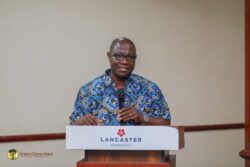There are varied aspects of leadership that amalgamate to make an effective leader. In previous writings, we have discussed a few. Today, we tackle another skill that is not only very essential but delicate in leadership. Currently all around the world, many leaders are having to exhibit this skill in a series of ways. As populations look up to world leaders, they are expecting a show of empathy, wisdom and charisma. But one thing must still stand out, and that is confidence. How confidently can a leader execute his tasks in the midst of chaos? Psychology Today defines confidence as the belief in one’s ability to succeed. The Latin origin of the word confidence also defines it as “the belief in something” or “to have full trust in something”. Self-confidence is defined as “the full trust or belief in yourself”.
As Francisco Dao, a lifelong entrepreneur, says, “Self-confidence is the fundamental basis from which leadership grows. Trying to teach leadership without first building confidence is like building a house on a foundation of sand. It may have a nice coat of paint, but it is ultimately shaky at best.” While the leadership community has focused on passion, communication, and empowerment, they have ignored this most basic element and, in the process, they have planted these other components of leadership in a bed of quicksand. (Forbes, 2008)
Leaders who lack confidence have challenges with gathering and maintaining followership. Sometimes, leaders lack confidence even when they have a comprehensive level of competence. Other leaders do not have the competence but are confident in their ignorance. The most common challenge is the weak connection between confidence and competence which many leaders grapple with. Leaders who struggle with low confidence sometimes face the challenge of being ambitious with their goals for the team and the goals for their personal lives.

Another challenge with exhibiting confidence comes from the consequences of making certain decisions. Although tempting, do not pursue respect in place of likability. Indeed, I have discussed several times the important of likability in leadership. However, as leaders, we must not exchange the need for doing the right or respectable thing with the need for likability. A show of confidence is reflective of making the hard choices. An article by Forbes explains it this way: If you live your life making decisions based on what others think of you, you will not lead your own life. If you can’t lead your own life, you can’t make an impact on others. Stop worrying about being liked by others, and start focusing on being respected. Leaders make decisions, and not all of them are well received. But they make decisions regardless because they believe it is the right thing to do. Whatever path you take, someone will be there to criticize you. You can’t live life not doing anything out of fear of disapproval. Eleanor Roosevelt said, “Do what you feel in your heart to be right – for you’ll be criticized anyway. When all has been said and done, the end will justify the means.
People don’t want to follow leaders who show uncertainty and anxiety. Fear is contagious, as is confidence, but in a more productive direction. As Steve Kerr, Golden State Warriors Coach says in the quote at the outset, “your team needs to see you as confident,” with the unspoken implication being… even if privately you may not completely feel that way.
In quite a number of cases, the lack of confidence of a leader is communicated through arrogance, bragging or blustering in their attempt to make up for the lack or the inadequacy of trust in themselves. There is always a cloud of self-doubt that forces them to assume people are always out to attack them. A display of these characters undermines the position of the leader and opens the gateway for disrespect from employees and colleagues.
Instructions may always be received with insolence and conceit and productivity, more often than not, turns out to be very low. Decisions made by such leaders may also tend to lack clarity and may be the evidence of the challenge of the poor display of self-confidence. Not only does confidence allow you to make the sturdy decisions that people expect from a strong leader but it is reassuring to your employees. Lastly, the complication of an unconfident leader reflects in his style and process of communication. The portal for mistrust and mockery is widely open due to this difficulty.
The sources of confidence may vary from person to person. While others are aware of the ingenuity and uniqueness of the competencies they possess, others may have been coached to develop this trait. Confidence as it stands at every point in time can be a trait or a state. An article by Till H. Grob in 2015 discloses that in psychology there is the saying “state over trait,” meaning that your momentary state is a lot more important than your underlying trait. What truly matters when it comes to confidence is not just the inherence and awareness that you are confident, but the momentary showcase of this value in a specific area. In essence, confidence is of value as both a state and a trait. However, what you do with your confidence becomes the state of your confidence when the need arises.
One of the highest confidence measures stems from preparation and the belief thereof in the competence you have worked to gain. The successive output of good performances and the visualization of positive outcomes also contributes to the display of self-confidence. Of course, it is usually easier to display this trait when you have a solid track record of succeeding in a particular field. What hope is there for people who lack the innate advantage, self-awareness, competitive advantage or trust in themselves? How do you build the needed confidence at every stage in your life, love and labour as a leader?
The first key to understand confidence is the YOU factor. When you can show up for YOURSELF not others, you honour your own word to yourself, you realize that you begin to have a feeling of calm and composure when engaging others.

I would like to share 4 key tips to train yourself as a leader on the journey to confidence:
- Generate Awareness
Raise the needed necessity to be aware of your current position. Be honest and truthful about your fears, especially your imaginations about how people perceive you. You may draw from past engagement with and around people to find out how and what you think about you. Then you look at the positive sides and make a self-awareness profile. This level of insight will open the doors on how to kick start the journey.
- Submit & Surrender
This is a set aside period of vulnerability to seek feedback and listen to others tell you about you. During this period as you engage people spend time in getting to see yourself through their eyes. What do they see, feel and hear? What is their reaction or response to your level of leadership and confidence? Compile this information and assess every weak point, even the smallest things, and start thinking of how you can fix the issues.
- Connect Your Reputation with YOU
Give yourself tasks and assignments beyond your comfort zone and for each event that you are committed to. Show up every single time, even if it is difficult. As the Havard Business review succinctly puts it, “Confidence equals security equals positive emotion equals better performance,” says Tony Schwartz, the president and CEO of The Energy Project and the author of Be Excellent at Anything: The Four Keys to Transforming the Way We Work and Live.”
- Deliver on the Execution/Plan
When you have been through awareness and surrender and you have been introduced, you then need to find your way. Body language is 55% of what we communicate, therefore we need to master our communication in that area. The frame of your face is very key. You must always have a smile and make eye contact. Be aware of your posture at all times. Do not slouch. The HBR also adds that, you must practise doing the things you are unsure about, embrace new opportunities to prove you can do difficult things and be honest with yourself about what you know and what you still need to learn. Do not focus excessively on whether you or not you have the ability – think instead about the value you provide, hesitate to ask for external validation if you need it, worry about what others think — focus on yourself, not a theoretical and judgmental audience.
Whilst these are just key steps of the journey they are very critical if practised to bring you to a place where you can make initial connections confidently. As leaders or aspiring leaders, we are already aware of how much of a role practice and consistency can play in our total transformation.
The message is: Simply Start and Connect Consistently.
There is an audience of people who are ready to hear what you have to say,
to learn from your experience, your skills, and be inspired by your passion.
But so many of us get stuck trying to discover our message and how to
communicate it, and we end up unable to find it so that we can build a
brand and business around it. My goal here is to support you to find
clarity around your message, and express yourself with integrity,
and confidence in everyday work situations around it, especially
when the pressure’s on. Sign up now to attend the Speaker’s
Bootcamp class on NOVEMBER 5TH











